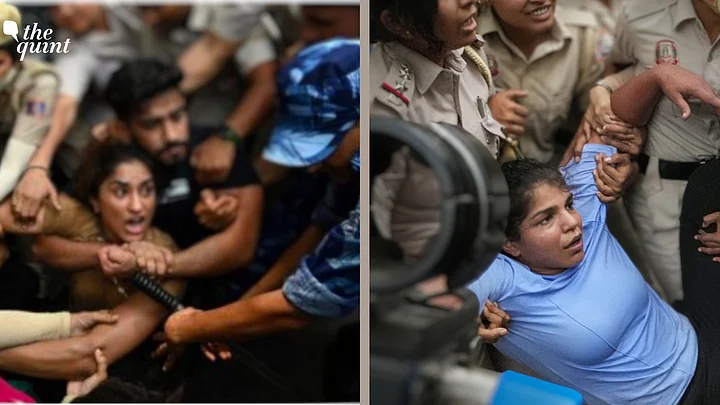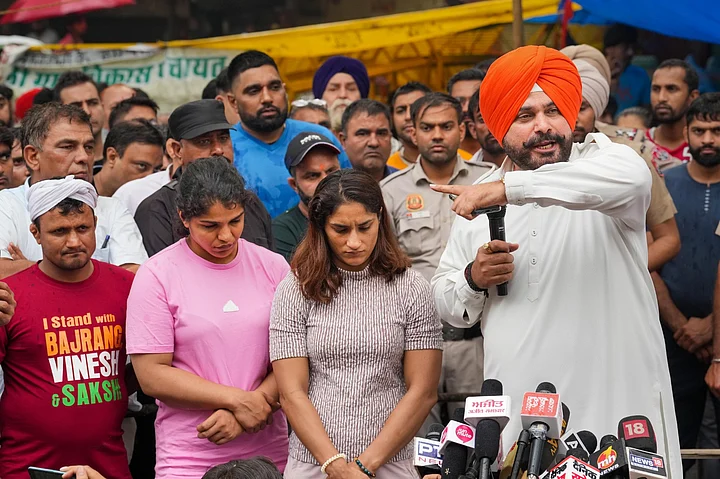“The manner in which the wrestlers have been dealt with and treated is despicable,” former Supreme Court Justice Madan Lokur told The Quint as visuals trickled in of Indian wrestlers being grabbed, dragged and hurled into police vehicles.
Later that night (of Sunday, 28 May), the police also registered an FIR against them under several sections of the IPC as well as Prevention of Damage to Public Property Act.
Justice Lokur, thereby, added:
QUICK RECAP:
Several Indian wrestlers including Sakshi Malik, Bajrang Punia, and Vinesh Phogat have been protesting against the Wrestling Federation of India (WFI) chief and BJP MP Brij Bhushan Singh in connection with the sexual harassment allegations against him.
While the police was initially reluctant to register even an FIR against the MP, telling the Supreme Court of India that they wanted to probe the complaints first; as the wrestlers' plea continued to be heard by the top court, two FIRs were subsequently filed.
One of the two, incidentally is under the POCSO Act, pertaining to allegations of sexual assault of a minor.
Given the seriousness of the purported offences, as well as Singh’s undiluted position of power, the wrestlers as well as members of the civil society have long sought his arrest. Hence, they have been protesting for nearly a month now in the national capital.
Except on 28 May, as Prime Minister Narendra Modi inaugurated the new parliament — “temple of democracy,” he called it— the protest was forcefully and quite undemocratically - one might argue, quelled by the police. And to this end, the Delhi Police did not appear, at least in the many visuals that emerged, to have stopped short of using violence.
THE POLICE’S VERSION?
In their FIR against the wrestlers, the police reportedly claimed that they attempted to stop the protesters because the new parliament building was being inaugurated simultaneously.
The Indian Express quoted the police as having said that the new building is a “matter of pride and glory for the nation” and so “its security cannot be compromised."
The Delhi Police’s claim is that Section 144 was imposed in the area, and they had told the protesters to remain at Jantar Mantar.
But the protesters did not listen, and the police alleges that “while trying to stop the protesters,” they (as in the police, themselves!), “were manhandled and assaulted”. They even added that some personnel purportedly sustained injuries.
But what of the photographs and visuals that show large crowds of police personnel (including members of the Rapid Action Force) pulling, from all directions, at a terrified-looking Vinesh Phogat; or physically carrying an evidently helpless Sakshi Mallik?
The versions appear inconsistent, at best.
However, as pointed out by Advocate Abhinav Sekhri:
BUT WHAT HAVE OUR COURTS SAID ABOUT A CITIZEN'S RIGHT TO PROTEST?
The wrestlers have been sitting in protest at Delhi’s Jantar Mantar since 23 April and even though political leaders and members of many communities have joined the protest across the month, there have never been any reported threats of violence or physical harm made by the wrestlers or their supporters. Even on Sunday, the wrestlers were unarmed.
So did the police-force need to come down on them as heavily as it did?
No. Even orders under Section 144 CrPC cannot be used to curtail legitimate protest, legal experts have pointed out to The Quint.
In Madhu Limaye vs Sub-Divisional Magistrate, Monghyr and Others (1970), a Constitution bench of the apex court held that “law abiding citizens protesting for the realisation of basic human rights, cannot be restricted by orders under this section.”
“The key part of the section (144 CrPC) is to free society from serious disturbances of a grave character, which cannot be true of a dharna or protest by citizens groups on issues that affect governance and a just realisation of citizens’ rights guaranteed by the Constitution of India.” (Emphasis added)
In 2012 (Ramlila Maidan case) the Supreme Court held that when the police inoveks Section 144, “the requirements of existence of sufficient ground and need for immediate prevention or speedy remedy is of prime significance."
“In this context, the perception of the officer recording the desired/contemplated satisfaction has to be reasonable, least invasive and bona fide. The restraint has to be reasonable and further must be minimal…The most onerous duty that is cast upon the empowered officer…is that the perception of threat to public peace and tranquility should be real and not quandary, imaginary or a mere likely possibility.”
What transpired on Sunday does not appear to have been least invasive, to say the least.
As pointed out by Advocate Harshit Anand:
WHAT THE ENTIRE SEQUENCE OF EVENTS SHOW
Meanwhile according to Justice Lokur, the entire sequence of events — beginning from January, when the allegations against Brij Bhushan Singh first emerged — gives an impression that the wrestlers have been taken for a ride.
“First of all, some committee was set up so that the protest would be called off. This is an old tactic and the wrestlers fell for it, obviously not being savvy in these matters. The committee gave a report in April but more than a month has gone by and the report has not seen the light of day as if it is some kind of a national secret.”
Lamenting the treatment that has been continuously meted out the wrestlers, Justice Lokur added:
“Nobody has bothered to give them a proper hearing. On the contrary, they have been physically evicted from Jantar Mantar, their belongings taken away and the tents in which they were staying have been pulled down. In a sign of vindictiveness, they have been prevented from going back to the protest site. A clear message has been sent to them and to other protesters that the police will not encourage any protest, but if people want to protest, they should be prepared to be manhandled.”
“Are they and all others being told that you can protest in Delhi, if at all, only until the police lets you?” the former Supreme Court judge asked.
At this intersection, thus, lies one final question: Will democracy survive in the shadows of its new temple?


